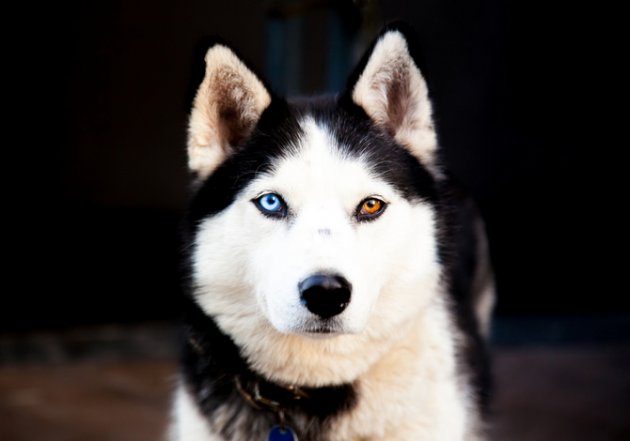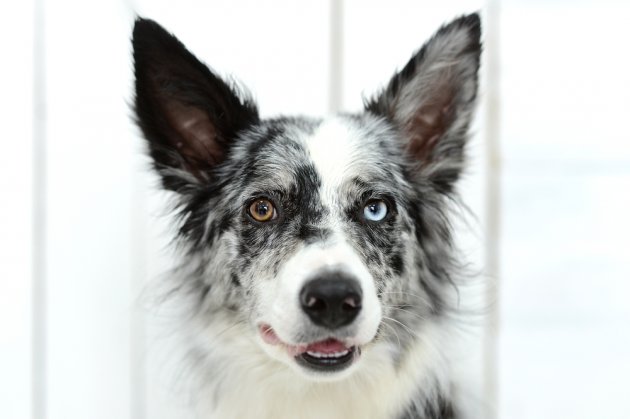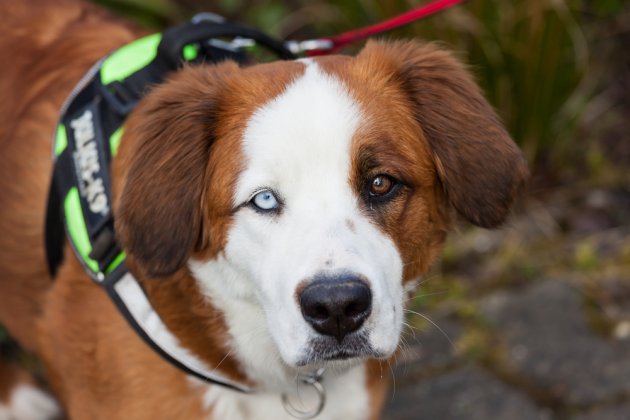You may or may not have seen a dog with two different colored eyes. If you have, you will probably agree it is undeniably beautiful, albeit, a bit weird. The scientific term for this “oddity” is Heterochromia irides, and it’s not as rare as you may think. Dogs, cats, and even people can all have this condition.
In this post, we will explore heterochromia, what it means for the dog that has it, and the most popular breeds that are prone to this condition. We will also dispel some myths surrounding this genetic default.
Let’s get started.

Heterochromia in Dogs
The color of the eyes (in any species) is determined by a substance called melanin (which is a pigment), more specifically, either too much melanin or a lack of it. For example, brown eyes have more pigment than blue eyes.
Heterochromia is a genetic condition, or it can also develop because of an injury to the eye. Heterochromia (through genetics) is not dangerous to the dog. The canine will still have the same vision out of both eyes, as those with same colored eyes, regardless of the color.
Are you still worried about your Heterochromia dog's vision? Perform this simple test. Have a person sit behind the dog and cover the pigmented eye (the brown one). Now drop a colorful bouncy ball in front of your pooch. Does its eye follow the ball? Then its vision is likely normal.

Types of Heterochromia in Dogs
According to All About Vision, there are three types of Heterochromia, all based on where the color is located in the eye.
Complete Heterochromia - as the name suggests, this type of Heterochromia is when the iris of the eye (the thin circular portion that surrounds the pupil and contains the color) is an entirely different color from the other eye's iris.
Partial/Sectoral Heterochromia - this is when only a portion of the iris is affected by a different color. It can occur in one or both eyes.
AdvertisementCentral Heterochromia - the iris has a different color near the border of the pupil, which then has spikes of the primary color radiating from the pupil to the middle of the iris.
Deafness and Heterochromia
There is no link between deafness and heterochromia, per say. Researchers have noted that dogs with the genetics for piebald (pigmented patterns on white) and merle coats do influence both the genes for deafness and heterochromia, so canines with these attributes may be more likely to be deaf and with heterochromia.

Light Sensitivity and Heterochromia
Dogs with one blue eye may experience light sensitivity in that eye because of the lack of pigmentation. This could cause pain or discomfort to your pooch, so you may want to keep your heterochromia canine out of the bright sunlight or invest in a pair of doggy shades or goggles for those sunny day walks.
Dog Breeds Prone to Heterochromia
Surprisingly, there are several dog breeds prone to heterochromia. Huskies, Australian Shepherds, and the Catahoula Leopard Dog are the most prone.
According to the American Kennel Club, the Siberian Husky is permitted to have one brown, or one blue eye, or those with colored flecks in them. The same heterochromia is allowed in both the Aussie breed and the Catahoula Leopard Dog.
Dog Breeds Prone to Sectoral Heterochromia
As we discovered earlier, those dog breeds that exhibit merle coats are also prone to this condition, albeit mostly on the sectoral (partial) side. This type of heterochromia is usually the result of modified recessive D and B series genes, which causes the eyes to be shades of yellow-green to yellowish-grey.
Sectoral Heterochromia is common in;
- Great Danes
- Welsh Corgis
- Catahoula Cur
- Border Collies
- Australian Cattle Dogs
Other Breeds Prone to Heterochromia
There are still more breeds that are apt to have heterochromia. They include;
- Dachshunds
- Beagles
- Chihuahuas
- Shetland Sheepdogs
Why are some breeds more likely to have heterochromia? Researchers are still exploring the reasons behind this anomaly and are unable to find and reasonable answers. Breeders, however, are not thrilled when heterochromia shows up in a puppy, as it is considered a “defect” leaving the dog “unshowable.”

Myths of Heterochromia in Dogs
There are several myths and legends associated with heterochromia in dogs. Native Americans believe that dogs with one blue eye and one brown eye can see both heaven and earth at the same time.
Some myths tell how canines with brown or red eyes are spirit dogs, while those that possess two different colored eyes are natural protectors. Another legend states that sled dogs with heterochromia are faster than their dual-colored-eyed counterparts.
It's unlikely that these myths and legends hold any water to this genetic anomaly, but it is fun to think about.
Heterochromia and Your Dog
If you have a dog with heterochromia, count yourself among the lucky pet parents that enjoy this beautiful and intriguing genetic default in your very own pet. Although scientists are still trying to figure out exactly what causes this oddity, your dog is perfectly safe (even if it does have to wear sunglasses on a bright day)! And if you are completely in love with these odd-ball-eyeballs, there are plenty of breeds that are prone to this condition, so keep your eyes peeled for the heterochromia pooch. Who knows? Maybe it can see both heaven and earth...
References and further readings:
- bva.co.uk, Hereditary eye disease in dogs
- Keith C. Barnett OBE MA PhD BSc DVOphthal FRCVS DipECVO, Diagnostic Atlas of Veterinary Ophthalmology(Buy book)